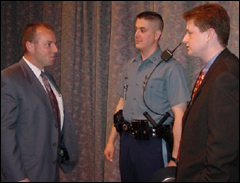| May 15 - 21, 2000
How to Prepare
and Respond to a School-Based Critical Incident
School emergencies can range from a school shooting to a false alarm fire drill, but how do officials, parents and teachers ensure that they are prepared to handle all that comes through the school doors? Recently, Massachusetts Lt. Governor Jane Swift offered a Technical Assistance Seminar to address school-based violence and spotlighted the importance of planning for school emergencies providing suggestions that can be applied and adapted to fit the needs of communities nationwide. The Executive Office of Public Safety, through the Massachusetts State Police and the Department of Fire Services, developed School Emergencies: Community Pre-Planning Guide as a series of questions and recommendations to assist schools and communities in assessing safety of their facilities, and help develop plans to effectively respond to emergencies and afford the greatest protection to students, staff and the general public. Early detection and prevention is an adage that many believe holds true for school safety. Identifying areas that can be helpful or harmful in emergency situations is critical for effective response. School violence takes many forms ranging from physical violence such as bullying and fist fighting to utilizing weapons such as guns and knifes. But most experts agree that there is no one-size-fits-all response. Massachusetts officials have encouraged the standardization of school emergency pre-planning efforts so that when a crisis occurs, law enforcement, fire personnel and others will have key information in a standard format at their fingertips. The Team
Critical Incident Response and Management The guide was not designed to tell communities how to develop their plans, but rather to offer a list of things to consider while developing a plan. The premise is that planners begin with internal facility pre-plans, and then work outward to include school grounds, the local community and the community at large. Internal Facility Pre-Plans According to the guide, internal facilities refer to all buildings that constitute a school campus. This includes maintenance sheds, administration buildings, athletic facilities and other structures. Though some buildings are not occupied full-time, these buildings may contain tools that may be used in an act of violence and should therefore be included in the pre-plans. “Take the basic floor plan and go through this rather lengthy list,” said Ladd. “You have to consider each and every room and each and every aspect.” The following is a guideline of locations, structures and uses to identify:
Electrical control rooms and panels Utility access/controls Classrooms/Labs, including chemistry labs - Precursor chemicals Interior Maintenance Areas - Cleaning supplies - Flammable combustible storage Engineering areas - Boiler Treatment chemicals Vocational shop areas - Compressed gases - Liquid fuels Swimming pools - Pool chemicals – Chlorine Grounds Maintenance - Pesticides – Organophosphates Kitchens and Food Storage Areas - Refrigeration gases – Ammonia - Potential for deliberate food contamination Civil Defense Supplies - Ether, Morphine - Fire control devices including alarm boxes, sprinklers and hand-held extinguishers
Location and accessibility of air intakes Filtration media location and accessibility Shutdown procedures
For example, if the school needs to be evacuated, the school administration should have an agreement with the bus company so that the students can be picked up in an alternate location. It may not be safe to have students filing back into a dangerous area to catch a bus. If a school has an agreement with a local business to allow students to evacuate into the business and no one has notified the police of the arrangement, then law enforcement personnel can’t locate the students at the scene. “This is not a how-to guide. It is simply a series of prompts,” to encourage discussion about potential obstacles and key information,” said Hakkarainen. He believes that there are three situations in which school administrators should define a decision, action, threshold plan defining what has to occur to prompt: a full evacuation, a horizontal evacuation (evacuate from one area of the school to another) or put students into a shelter (have students and staff go into designated safe rooms). School Grounds Pre-Planning “You need to conduct an assessment of the school grounds just as you did on the inside and look at what is there to help you and hurt you,” said Ladd. “School Grounds” refer to the outside property of the school and any property, such as public parking lots or parks that are routinely used by the school for assembly points during fire drills or school athletic events. When planning for school grounds evacuation/use it is recommended that schools consider two scenarios: the location of an emergency, and as the primary evacuation route from the school building. While conducting pre-planning for school grounds use it is recommended that planners consider the protection school grounds provide during an evacuation, and the protection school grounds provide persons within the school from a perpetrator on the grounds. The following is a suggested list of things to identify while doing school grounds pre-planning: 1. Routes from the building that provide cover while exiting the building. Where do these routes lead? Can they be identified as evacuation routes from a threat inside the school building? 2. Areas, such as athletic fields, that are behind ridges and not in view of or from the building. Can these safely be identified as collection points? 3. Evacuation routes and collection points that will be kept free of snow. 4. Access routes and loading areas for ambulances in the event of multiple injuries. This should be done for several locations around the building in concert with the planning of fire apparatus access. 5. Casualty collection points. Consider provisions for sheltering these points with deployable tents, etc. 6. Locations for the following functions
8. Locations from which a protected line-of-fire could be achieved. 9. Locations from which unauthorized access can be made to school grounds or buildings and methods to secure them from access. 10. Uncontrolled vehicle access to loading docks and unobserved schools entrances and methods to restrict access to them. 11. Parking that is close to the building and restrictions of access. 12. The need for pre-plans to call for clearing areas for emergency operations, including:
Local Community Pre-Planning After assessing the school grounds, the local community resources should be evaluated which includes identifying facilities, access and controls to evacuate students, staff and the injured away from the school when no safe location can be identified within the school building or on school grounds. These plans should also identify supports to emergency operations. In addition, local community pre-plans should assess hazards to schools and their populations. Hazards include chemical businesses that could cause additional problems if explosives are involved. Local facilities or locations may pose a hazard to persons entering the school, such as buses, as well as those posed during school hours. Sister School Programs “An incident at a school of this magnitude (such as Columbine) affects the whole community,” said Ladd. “If you have an incident at one school [school administrators need to look at] what happens at the other schools.” In the event that the main office is the first place attacked and the school needs to be evacuated – who had the attendance list? How will emergency personnel be able to know which students and staff are safely out of the school, remain in danger and are absent? An active attendance list is critical in an emergency situation. If each school has a sister school they could swap rosters at the beginning of each day so that in the case of an emergency students and staff will be able to be accounted for. It is advised to keep the emergency response plans in a couple different locations. “You need to have the ability to get to that plan in the event that you can’t get into that school,” said Ladd. Having a lock box can be a valuable tool, but it is advised that other locations be designated to hold the plans. “You don’t want these plans to fall into the hands of anyone who doesn’t need them,” said Ladd. Resources
159 Burgin Parkway | Quincy, MA 02169 617-471-4445 | Fax 617-770-3339 |
 The
guide recommends that communities assemble a multidisciplinary planning
team consisting of local public safety leaders, school administrators,
and most importantly, those who must manage an emergency situation. “In
reality this effort cannot be conducted effectively by any one group,”
said David Ladd, Director of the Massachusetts Department of Fire
Services Hazardous Materials Emergency Response (featured right in the
photo). Each community has different needs and developing plans locally
by including those most familiar with the community and schools can help
ensure maximum results.
The
guide recommends that communities assemble a multidisciplinary planning
team consisting of local public safety leaders, school administrators,
and most importantly, those who must manage an emergency situation. “In
reality this effort cannot be conducted effectively by any one group,”
said David Ladd, Director of the Massachusetts Department of Fire
Services Hazardous Materials Emergency Response (featured right in the
photo). Each community has different needs and developing plans locally
by including those most familiar with the community and schools can help
ensure maximum results.
 According
to Trooper Adam Hakkarainen, Director of the Massachusetts State
Police Professional Educator’s Awareness Training (PEAT) (featured in middle
of photo) , during a crisis and extensive plan can help; law enforcement
agencies obtain quick access to key information and key people.
According
to Trooper Adam Hakkarainen, Director of the Massachusetts State
Police Professional Educator’s Awareness Training (PEAT) (featured in middle
of photo) , during a crisis and extensive plan can help; law enforcement
agencies obtain quick access to key information and key people.